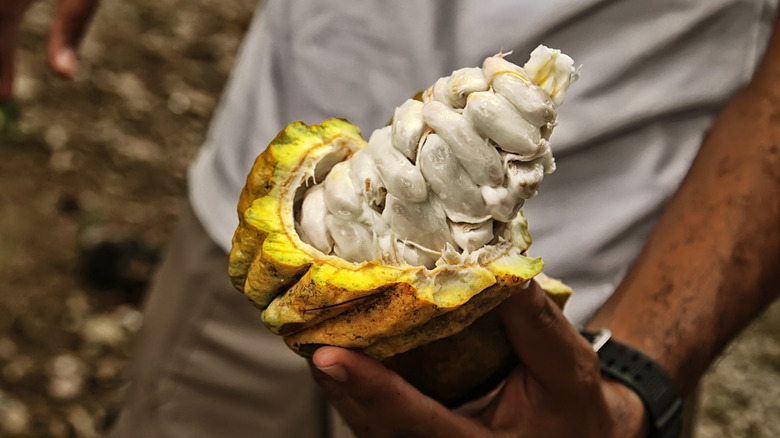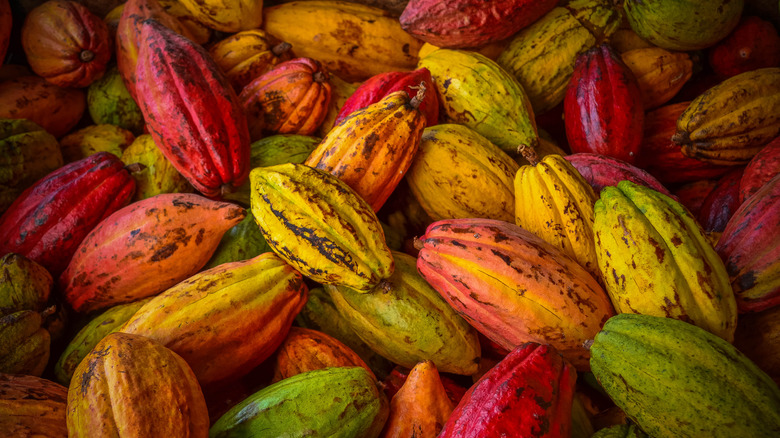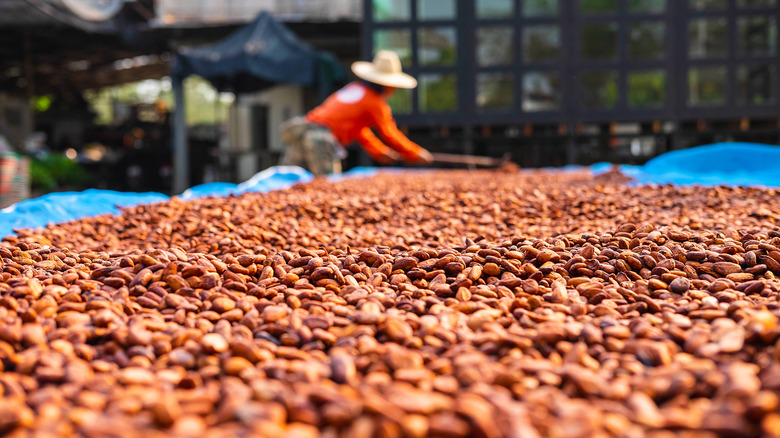Does Terroir Matter For Cacao Beans?
Chocolate — it's hard to name a single food that generates so much excitement. And it's not just positive associations that explain human's love for the substance. Containing 1,500 chemicals responsible for flavor, it's one of the most complex consumable foods. Add in some health benefits and chemical components that boost mood, love, and pleasure, and it's not surprising chocolate has such an esteemed reputation (via The Australian Academy of Science).
Chocolate starts from cocoa beans, the seed of the cocoa fruit. Much like coffee, these trees are grown in tropical regions not far from the equator. West Africa, specifically Ivory Coast and Ghana, dominate global growth (per Make Chocolate Fair), but most chocolate is produced In Europe. Such a globalized relationship between growers and producers is a complicated facet of chocolate production. In recent years, more and more chocolate makers have been applying terroir in regard to their sweet products. A French term most frequently summarized as "a sense of place," this piece of wine lexicon examines how a place and its climate impact the final product (via Vinepair). So does terroir impact cocoa beans, too? Let's dive in.
Geographic origins of chocolate influence its flavor
There are parallel aspects of terroir for both wine and chocolate. Cocoa, like grapes, imparts specific flavors through its genotype, soil, surrounding climate, and techniques of the producer. Just like with coffee or wine, it's necessary to start with single-origin chocolate to delineate terroir– meaning purchasing a bar with cocoa sourced from one location, notes Hotel Chocolat. However, unlike wine, procuring true single-origin chocolate isn't so easy. Many bars labeled single origin aren't necessarily produced in one farm, notes author Maricel Presilla in an interview for the New York Times. Usually, single origin denotes cocoa collected from farms in one region or country — say, a particular island in Indonesia or across Ghana. Such terminology makes it more challenging to distinguish flavors based on the source. One bar of chocolate can encompass different varieties and soils.
Nonetheless, there are unifying characteristics among origins. Regions typically have similar tasting notes, and it's possible to categorize some tasting notes. However, keep in mind that the geographic origin is only one aspect of the terroir — other chocolate-making factors complicate the terroir's significance.
Most factors of a cocoa's processing are too complex to categorize
The entire chocolate creation process is subject to many variabilities, making systematizing its terroir more complicated than it is for wine. First, there's the issue of genetic distinction. Wine grapes on the same plant are genetically identical — meaning they'll dependably offer similar flavor characteristics. However, a cocoa tree produces pods with different genetic makeup, so it's much harder to categorize based on the plant. Additionally, wine varietals go through more regulations and are usually processed in one facility — resulting in more consistency. Meanwhile, cacao pods are usually exported and turned into chocolate abroad, far away from the farm, explains Chocolate Class.
The human-led aspects of chocolate processing are incredibly irregular, even across a particular region. Everything from kernel fermentation, storage, drying methods, roasting, and refining, is susceptible to variance. While the location and weather of the cocoa do impact the taste, it's far outshined by the stages of chocolate manufacturing. So while details of terroir are undoubtedly a factor, there's not enough research to back what's categorized on a label, notes Bean to Bar World. Misused as a marketing term by producers, it's not to say chocolate isn't worthy of terroir, but instead that it's too complicated for it.


